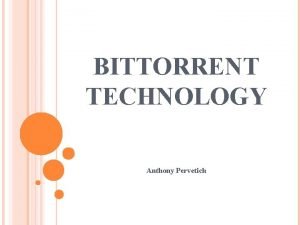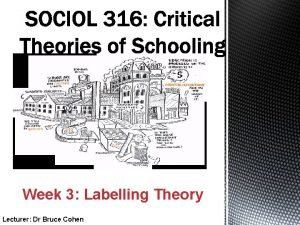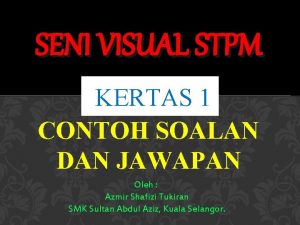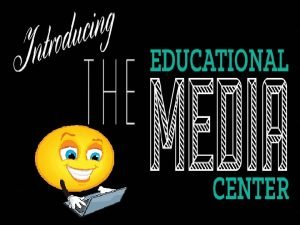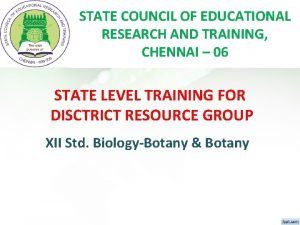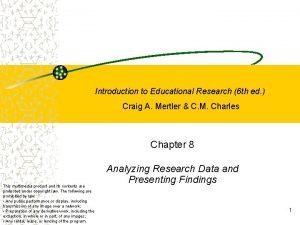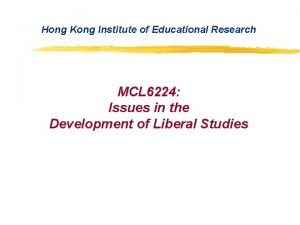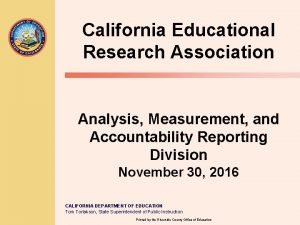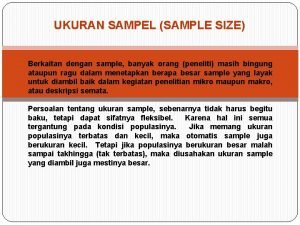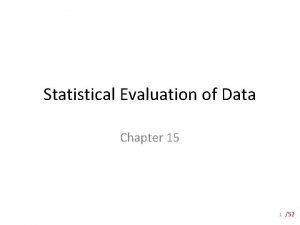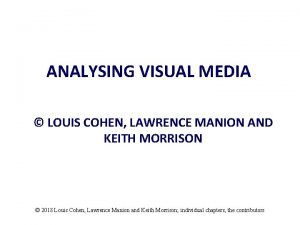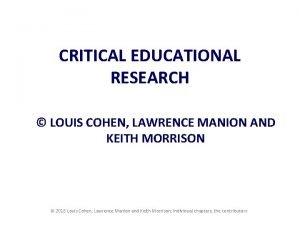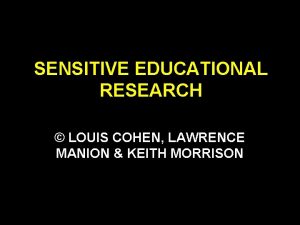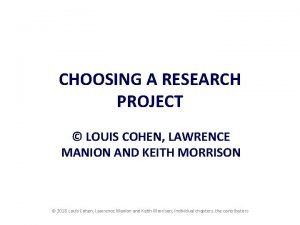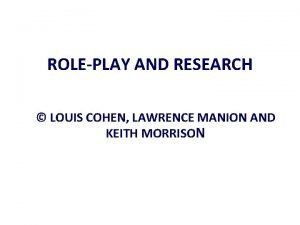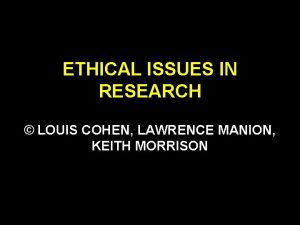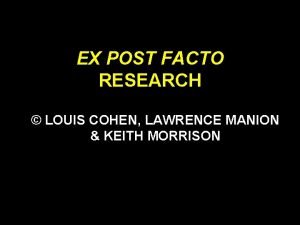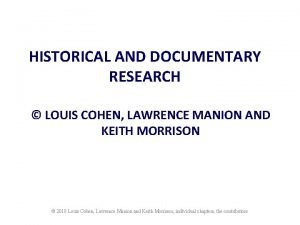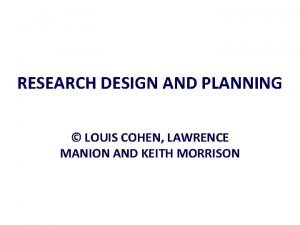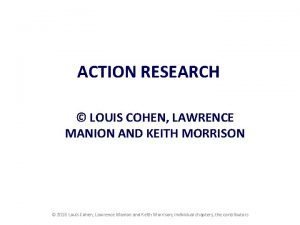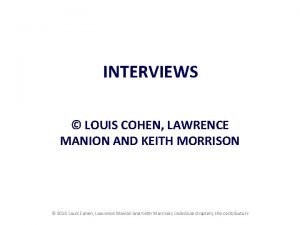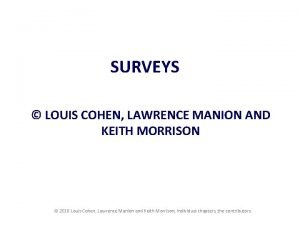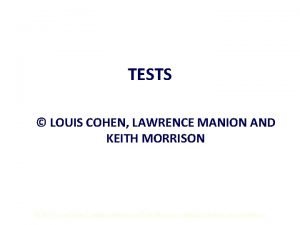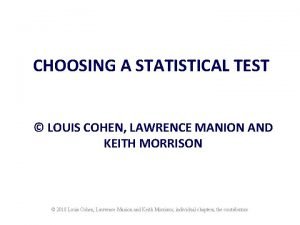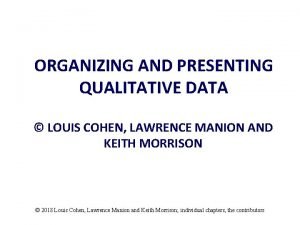VISUAL MEDIA IN EDUCATIONAL RESEARCH LOUIS COHEN LAWRENCE



















- Slides: 19

VISUAL MEDIA IN EDUCATIONAL RESEARCH © LOUIS COHEN, LAWRENCE MANION AND KEITH MORRISON © 2018 Louis Cohen, Lawrence Manion and Keith Morrison; individual chapters, the contributors

STRUCTURE OF THE CHAPTER • • Photographs and still images Video and moving images Artefacts Ethical practices in visual research © 2018 Louis Cohen, Lawrence Manion and Keith Morrison; individual chapters, the contributors

VISUAL IMAGES Anything we see, watch or look at counts as a visual image Four kinds of visual data: • Found data • Researcher created data • Respondent created data • Representations (e. g. graphical representations) Using visual media concerns: • The production of the image • The image itself © 2018 Louis Cohen, Lawrence Manion and Keith Morrison; individual chapters, the contributors • The audiences of the image

VISUAL IMAGES • Visual media are not neutral; they give messages, and we interpret them in many different ways. • We bring our own values, biographies, cultures and backgrounds to bear on images. • Images cannot be viewed outside the social and cultural contexts of the production of the image, the observing and interpretation of the image, the consideration of who are the audiences, intended or otherwise, of the image. • Images are made, kept and displayed in different places, each of which confers its own required social behaviours and audience reactions. © 2018 Louis Cohen, Lawrence Manion and Keith Morrison; individual chapters, the contributors

VISUAL IMAGES • An image is the product of: – certain technologies; – certain compositional features; – certain social contexts. • The image maker is selective: s/he has already decided what to include or not to include, what to focus on, what not to focus on, where to point the camera, where not to point the camera. • Regard images as discourses. © 2018 Louis Cohen, Lawrence Manion and Keith Morrison; individual chapters, the contributors

PHOTOGRAPHS AND STILL IMAGES • Photographs and still images are both emic and etic. They carry documentary and interpretive meaning, either posed or natural. • Researchers can take photographs and ask the participants to comment on them. • Researchers can ask participants either to take their own photographs or bring them to an interview to discuss them. © 2018 Louis Cohen, Lawrence Manion and Keith Morrison; individual chapters, the contributors

TYPES OF PHOTO-ELICITATION Autodriving • The researcher and/or participants can provide the photographs but participants take the lead Reflexive photography • Participants take the photographs and then, at interview, are asked to reflect on these Photo novella • Participants take photographs which tell a story about part/all of their lives © 2018 Louis Cohen, Lawrence Manion and Keith Morrison; individual chapters, the contributors

TYPES OF PHOTO-ELICITATION Photovoice • Participants photograph those parts of their society/community/environment which have meaning for them or which they feel need to change. Photo-observation • Photographing real objects, events, activities and discussing them Photo-interviewing © 2018 Louis Cohen, Lawrence Manion and Keith Morrison; individual chapters, the contributors

PHOTO-ELICITATION TECHNIQUE • The photograph, or set of photographs, or sequence of photographs, is used to invoke, prompt and promote discussion, reflections, comments, observations and memories. • Discuss what they show, who took them, when, where, what is the story behind them. • Ask participants to select images from their own or researcher-provided images, or images selected on the basis of sampling techniques. © 2018 Louis Cohen, Lawrence Manion and Keith Morrison; individual chapters, the contributors

SEVEN STEPS IN PHOTO-ELICITATION Step 1 Step 2 Step 3 • The researcher sets the topic for the research or investigation • The researcher identifies and invites suitable participants for the study • The researcher briefs the participants about the purpose, agenda, requirements, operation, ethics, constraints, and conduct of the photograph provision Step 6 • The researcher and/or participants decide who will take and/or collect the photographs • The researcher and/or the participants take and/or collect the photographs • The photographs are brought to, and form part of, the interview or discussion Step 7 • Data are analyzed and the results reported Step 4 Step 5 © 2018 Louis Cohen, Lawrence Manion and Keith Morrison; individual chapters, the contributors

VIDEO AND MOVING IMAGES • Video material is live. • Video material can record evolving situations and interactions, details that the observer may miss, and non‑verbal matters. • Video material enables repeated viewing/checking. • Video material catches: – – – natural social situations; contrived situations; posed situations; special events; commissioned materials (e. g. a commemorative activity). © 2018 Louis Cohen, Lawrence Manion and Keith Morrison; individual chapters, the contributors

VIDEO AND MOVING IMAGES • Video material is selective (focus and location of camera, fixed or moving camera). • Consider: – Where, how, why, for whom, how and under what conditions the video was produced; – The interpretations that he or she (or indeed others) make or may make of the moving images; – How these interpretations are influenced by the interpreters’ own backgrounds, values and purposes (i. e. reflexivity). • How to analyse complex images and detail/data overload. © 2018 Louis Cohen, Lawrence Manion and Keith Morrison; individual chapters, the contributors

VIDEO AND MOVING IMAGES • Address legal and ethical matters: – permission to film – data protection – privacy – covert research – permission to show – intrusiveness © 2018 Louis Cohen, Lawrence Manion and Keith Morrison; individual chapters, the contributors

THREE CHALLENGES IN MOVING IMAGES • Balancing attention to close-up detail and the broader context, so that the broader context is not lost. • Avoiding data overload, particularly magnifying events or details which might not be meaningful or important to participants. • Representing data, ensuring that audiences are able to judge if inferences that are made from the video are plausible. © 2018 Louis Cohen, Lawrence Manion and Keith Morrison; individual chapters, the contributors

ARTEFACTS • Artefacts may be easy to see/find but difficult to interpret: they do not always carry clear meanings in themselves. • Artefacts can be interpreted very differently; they have multiple interpretations. • Artefacts may indicate the hidden curriculum of an organization. • Artefacts can be seen, heard, smelt, touched, felt, tasted and heard; they are multi-sensory and may require multisensory analysis. • Artefacts may be provided by the researcher, participants, others or be present in a situation. © 2018 Louis Cohen, Lawrence Manion and Keith Morrison; individual chapters, the contributors

CONSIDERATIONS IN RESEARCHING ARTEFACTS • The purpose of the production and location of the artefact. • What it is/was used for and by whom. • Who produced it. • When it was made. • What materials have been used in its making. • What is/was its actual and/or symbolic purpose or function. • How it has been preserved and in what condition. • What value it has to the provider or user. © 2018 Louis Cohen, Lawrence Manion and Keith Morrison; individual chapters, the contributors

ARTEFACTS Artifacts may be used for exploring sensitive issues • The use of dolls in cases of sexual abuse • The use of puppets with different facial expressions • The use of puppets to act out a situation of conflict © 2018 Louis Cohen, Lawrence Manion and Keith Morrison; individual chapters, the contributors

ETHICAL PRACTICES IN VISUAL RESEARCH Informed consent. Permission for taking images. Permission for using images. Permission to take images in public places (what is a public place and what is a private place? ). • Legally and illegally taking or storing images. • • © 2018 Louis Cohen, Lawrence Manion and Keith Morrison; individual chapters, the contributors

ETHICAL PRACTICES IN VISUAL RESEARCH • Preferred and non-preferred sites for taking pictures. • Identification, anonymization and obscuring of individuals and places (ethical and legal regulation). • Informed consent, anonymity, non-traceability and confidentiality may be difficult. • Ethical codes for using images in research (and ownership of the image). • Do no harm. © 2018 Louis Cohen, Lawrence Manion and Keith Morrison; individual chapters, the contributors
 Mininova torrent
Mininova torrent Dr bruce cohen st louis mo
Dr bruce cohen st louis mo Louis vuitton vl
Louis vuitton vl Cara menjawab soalan seni visual stpm
Cara menjawab soalan seni visual stpm Importance of educational media center
Importance of educational media center Qualitative approach
Qualitative approach Correlational research advantages and disadvantages
Correlational research advantages and disadvantages Tnscert
Tnscert Educational research gay
Educational research gay Ethnographic research
Ethnographic research Educational research and development
Educational research and development Introduction to educational research mertler
Introduction to educational research mertler Categories of educational research
Categories of educational research Hong kong institute of educational research
Hong kong institute of educational research Interpretation in research example
Interpretation in research example California educational research association
California educational research association Apakah maksud visual pada kata pemrograman visual
Apakah maksud visual pada kata pemrograman visual Tabel cohen manion dan morrison
Tabel cohen manion dan morrison Effect size
Effect size Cohen's d effect size criteria
Cohen's d effect size criteria
